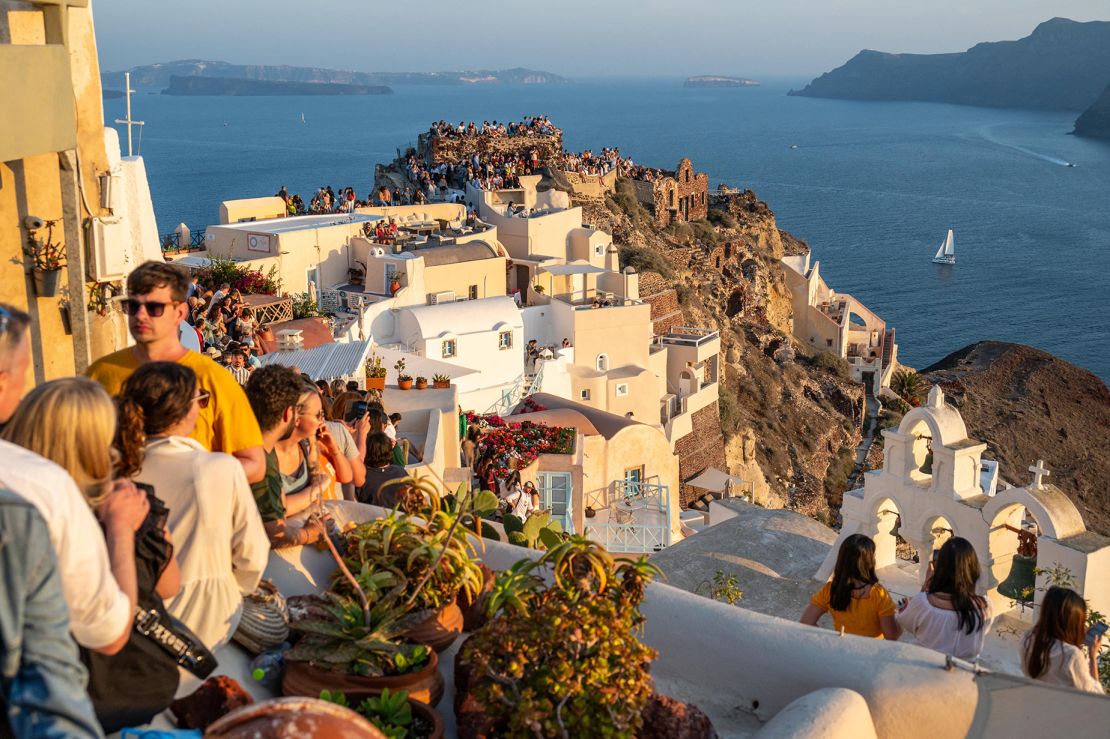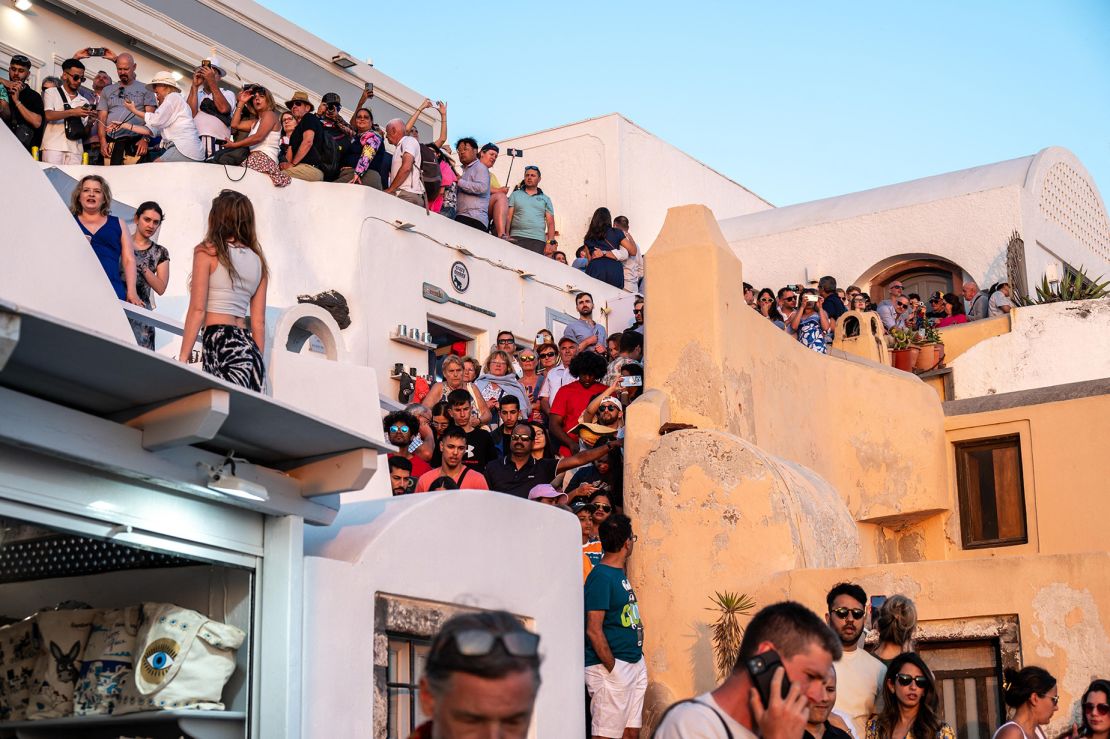Editor’s Note: Sign up for?Unlocking the World, CNN Travel’s weekly newsletter. Get the latest news in aviation, food and drink, where to stay and other travel developments.
There’s a volcano waiting to blow on Santorini, but it’s not the world-famous caldera.
The dazzling white-washed houses, blue-domed churches and azure skies and sea of this uniquely stunning Greek island pull in a reported 3.4 million visitors a year, far outnumbering Santorini’s 20,000 or so permanent residents.
As many as 17,000 cruise ship passengers surge onto the island on peak days in high season, heading straight to hot spots such as the capital Fira and the town of Oia on its northwestern tip, renowned for its spectacular sunsets. It’s even earned the nickname “Instagram island” because of its perfectly saturated “no filter” splendor.
The narrow cobbled streets and cliffside balconies are filled cheek to jowl with vacationers seeking sunset selfies, and locals are disturbed as they go about their daily business. When evening comes, however, the crowds melt away, and some complain the island goes from Times Square to ghost town.
It’s a volatile mix that’s led to discontent building on this Cyclades island in the Aegean Sea, whose rugged landscape was shaped by a volcanic eruption around 1600 BC.
Visitor cap coming in 2025
Santorini Mayor Nikos Zorzos has proposed a cap on cruise ship passengers, down to 8,000 a day. It’s a move backed by Prime Minister Kyriakos Mitsotakis, who told Bloomberg the measure is set for next year.
Anti-tourism protests have been a political flashpoint in Europe this summer, with demonstrations taking place in Spain, the Netherlands and beyond. On Thursday, Venice limited tour group sizes to 25 people and banned megaphones, having recently declared its temporary entrance fee a success, netting the city about $2.64 million in revenue.
Overtourism has become a major buzzword in travel in recent years as popular destinations struggle to balance their need for visitor dollars with the quality of life of their residents and maintaining a desirable and sustainable environment for all.
On Santorini, according to some, it’s not simply a case of too many tourists.

‘The island is empty’
“Overtourism doesn’t exist. What I see is a lack of structures,” Gianluca Chimenti, a local tour operator and a Santorini resident for 18 years, tells CNN Travel. While social media is filled with images of the severe overcrowding in the island’s hot spots at peak times, he says the picture the rest of the time is very different.
“The truth is that the island is empty. Right now is like never before, it’s the worst season ever.”
July and August are high season in Santorini, but the town centers are dead after 9 p.m., and restaurants and hotels are nowhere near capacity, he says. Cruise ship passengers are valued and much needed, as are those longer-stay visitors coming by boat or plane, but he says the feeling among locals is that something has to give.
In the mid- to late-20th century, Santorini was still a sleepy idyll where residents got around on donkeys and cultivated tomatoes and vineyards for wine. Now the island’s outdated infrastructure is under severe pressure, with the main port at Fira under particular strain.
Unless they want a long and very steep walk, the cable car is the only option for cruise ship passengers to get from the Old Port to the city center, points out Chimenti, and “it’s absolutely normal that you’re going to have a line if the cruise ships are coming all together.”
However, when the crowds are gone, “the hotels right now are more or less under 30% of a normal season,” he claims, and says that other businesses on the island are taking a similar hit.
“The problem is that the social media are showing something completely different from what is the reality,” he says. While many, many tourists will be visiting this year, there are also many others who are put off by its overcrowded reputation and are not considering it as a year-round destination for longer stays.
The need to diversify

Cruise Lines International Association (CLIA), a global trade body, announced on August 1 that it had met with Greece’s minister of maritime affairs, Christos Stylianides, to discuss the crisis, including improvement and upgrade of port infrastructure and services.
Greece’s tourism boom isn’t just in Santorini. National tourism revenues rose 16% in the first five months of this year, Reuters reports, and 2024 is expected to eclipse last year’s record 33 million arrivals.
“Recently, the growth of tourism in Greece has garnered significant attention, particularly concerning the islands of Santorini and Mykonos,” said Maria Deligianni, CLIA’s regional director for the Eastern Mediterranean, in a statement. She confirmed its cruise lines’ commitment to upholding the 8,000-passenger visitor cap and said that there was strong interest in diversifying Greek itineraries to take pressure off the most popular spots.
Currently, nearly two-thirds of cruise tourism in Greece takes place in Piraeus, Santorini and Mykonos, CLIA said.
“Santorini has one of the most important archaeological sites right now in Europe,” says Chimenti. “Why are cruise ships not organizing tours to the archaeological sites? If you split the people in three parts of the island, so at different times they are doing multiple things,” then he says, “they have time to enjoy and you will never have crowds in any part of the island.”
‘It was absolutely magical’
Santorini’s breathtakingly romantic vistas have made it a hugely popular choice for?honeymoons and destination weddings. Katie Haslam of Rochdale, England, spent her honeymoon there in July, but she says that careful planning was key to her and her husband, Rob, having the vacation of their dreams.
“We didn’t want to go to Fira because we’d read that it was really, really busy,” she says. Instead they chose a clifftop village just a few kilometers from the capital, and “it was just amazing, lovely and quiet.”
On the one day they walked into Fira, “I think there were about eight cruise ships that came in, thousands and thousands of people, so we just stayed away.”
Love was also in the air. “We saw at least two weddings every day,” she says. “One of the days, there was six weddings on.”
As for the famous sunsets, which like for so many others was their chief pull for visiting, they avoided the scrum in town and “sat on our balcony every night at 8 o’clock with a bottle of wine. It was absolutely magical.”










